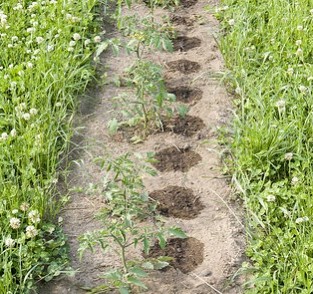 Drip irrigation is a simple and easy way to reduce water use.Photo courtesy of photofarmer via flickr
Drip irrigation is a simple and easy way to reduce water use.Photo courtesy of photofarmer via flickr
With water shortages constraining food production growth, the world needs an effort to raise water productivity similar to the one that nearly tripled land productivity over the last half-century. Since it takes 1,000 tons of water to produce 1 ton of grain, it is not surprising that 70 percent of world water use is devoted to irrigation. Thus, raising irrigation efficiency is central to raising water productivity overall.
Data on the efficiency of surface of water projects — that is, dams that deliver water to farmers through a network of canals — show that crop usage of irrigation water never reaches 100 percent simply because some irrigation water evaporates, some percolates downward, and some runs off. Water policy analysts Sandra Postel and Amy Vickers found that “surface water irrigation efficiency ranges between 25 and 40 percent in India, Mexico, Pakistan, the Philippines, and Thailand; between 40 and 45 percent in Malaysia and Morocco; and between 50 and 60 percent in Israel, Japan, and Taiwan.”
Irrigation water efficiency is affected not only by the type and condition of irrigation systems but also by soil type, temperature, and humidity. In hot arid regions, the evaporation of irrigation water is far higher than in cooler humid regions.
In a May 2004 meeting, China’s Minister of Water Resources Wang Shucheng outlined for me in some detail the plans to raise China’s irrigation efficiency from 43 percent in 2000 to 51 percent in 2010, and then to 55 percent in 2030. The steps he described included raising the price of water, providing incentives for adopting more irrigation-efficient technologies, and developing the local institutions to manage this process. Reaching these goals, he felt, would assure China’s future food security.
Raising irrigation efficiency typically means shifting from the less efficient flood or furrow systems to overhead sprinklers or drip irrigation, the gold standard of irrigation efficiency. Switching from flood or furrow to low-pressure sprinkler systems reduces water use by an estimated 30 percent, while switching to drip irrigation typically cuts water use in half.
As an alternative to furrow irrigation, a drip system also raises yields because it provides a steady supply of water with minimal losses to evaporation. Since drip systems are both labor-intensive and water-efficient, they are well suited to countries with a surplus of labor and a shortage of water. A few small countries — Cyprus, Israel, and Jordan — rely heavily on drip irrigation. Among the big three agricultural producers, this more efficient technology is used on 1-3 percent of irrigated land in India and China and on roughly 4 percent in the United States.
In recent years, small-scale drip-irrigation systems — literally a bucket with flexible plastic tubing to distribute the water — have been developed to irrigate small vegetable gardens with roughly 100 plants (covering 269 square feet). Somewhat larger systems using drums irrigate 1345 square feet. In both cases, the containers are elevated slightly, so that gravity distributes the water. Large-scale drip systems using plastic lines that can be moved easily are also becoming popular. These simple systems can pay for themselves in one year. By simultaneously reducing water costs and raising yields, they can dramatically raise incomes of smallholders.
Sandra Postel estimates that drip technology has the potential to profitably irrigate 25 million acres of India’s cropland, nearly one-tenth of the total. She sees a similar potential for China, which is now also expanding its drip irrigated area to save scarce water.
In the Punjab, with its extensive double cropping of wheat and rice, fast-falling water tables led the state farmers’ commission in 2007 to recommend a delay in transplanting rice from May to late June or early July. This would reduce irrigation water use by roughly one-third, since transplanting would coincide with the arrival of the monsoon. The resulting reduction in groundwater use would help stabilize the water table, which has fallen from 16 feet below the surface down to 98 feet in parts of the state.
Institutional shifts — specifically, moving the responsibility for managing irrigation systems from government agencies to local water users associations — can facilitate the more efficient use of water. In many countries farmers are organizing locally so they can assume this responsibility, and since they have an economic stake in good water management, they tend to do a better job than a distant government agency.
Mexico is a leader in developing water users associations. As of 2008, farmers associations managed more than 99 percent of the irrigated area held in public irrigation districts. One advantage of this shift for the government is that the cost of maintaining the irrigation system is assumed locally, reducing the drain on the treasury. This means that associations often need to charge more for irrigation water, but for farmers the production gains from managing their water supply themselves more than outweigh this additional outlay.
In Tunisia, where water users associations manage both irrigation and residential water, the number of associations increased from 340 in 1987 to 2,575 in 1999, covering much of the country. As of 2009, China has more than 40,000 water users associations to locally manage water resources and to maximize water use efficiency. Many other countries now have similar bodies. Although the first groups were organized to deal with large publicly developed irrigation systems, some recent ones have been formed to manage local groundwater irrigation as well. Their goal is to stabilize the water table to avoid aquifer depletion and the economic disruption that it brings to the community.
Low water productivity is often the result of low water prices. In many countries, subsidies lead to irrationally low water prices, creating the impression that water is abundant when in fact it is scarce. As water becomes scarce, it needs to be priced accordingly.
A new mindset is needed, a new way of thinking about water use. For example, shifting to more water-efficient crops wherever possible boosts water productivity. Rice production is being phased out around Beijing because rice is such a thirsty crop. Similarly, Egypt restricts rice production in favor of wheat.
Any measures that raise crop yields on irrigated land also raise the productivity of irrigation water. For people consuming unhealthy amounts of livestock products, moving down the food chain reduces water use. In the United States, where the annual consumption of grain as food and feed averages some 1,764 pounds (four-fifths of a ton) per person, a modest reduction in the consumption of meat, milk, and eggs could easily cut grain use per person by 220 pounds. For 300 million Americans, such a reduction would cut grain use by 30 million tons and the need for irrigation water by 30 billion tons.
Bringing water use down to the sustainable yield of aquifers and rivers worldwide involves a wide range of measures not only in agriculture but throughout the economy. The more obvious steps, in addition to more water-efficient irrigation practices and water-efficient crops, include adopting more water-efficient industrial processes and using both more water-efficient household appliances and those that use no water at all, such as the new odorless dry-compost toilets. Recycling urban water supplies is another obvious step in countries facing acute water shortages.
Adapted from Chapter 9, “Feeding Eight Billion People Well” in Lester R. Brown, Plan B 4.0: Mobilizing to Save Civilization (New York: W.W. Norton & Company, 2009), available online.



